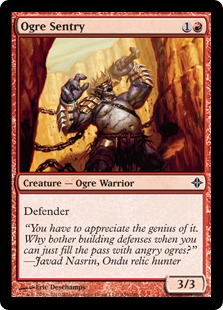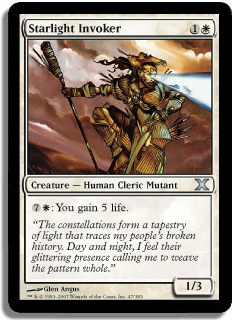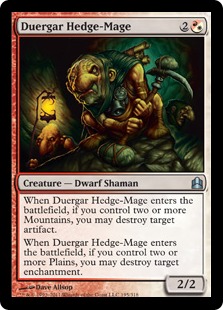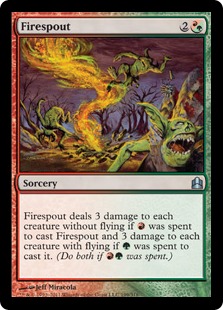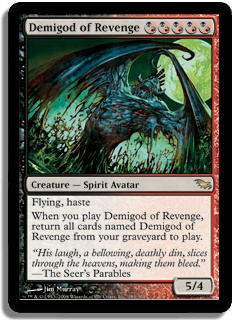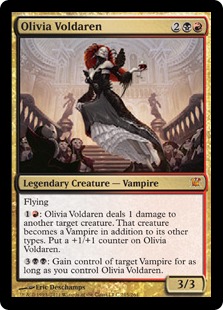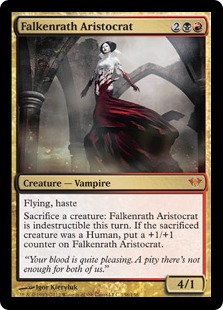[Editor’s note: This was written before the Return to Ravnica Party at PAX Prime.]
With Return to Ravnica on the horizon, people are looking at the multicolor sections of their cubes in anticipation of the new block to be able to accommodate those cards. We’ve only seen eight cards spoiled, and out of the five multicolor cards, two are very good for Cube (Izzet Charm and Dreg Mangler are both very efficient and solid cards in their respective multicolors, which I’ve found in testing). Although that is an admittedly small sample size, there are probably going to be a lot of new tools for cube designers. In this article, I’ll be talking about how multicolor plays a vital role in Cube and how to design your cube with multicolor in mind, as well as how to accommodate these powerful cards.
Have you ever wondered why Cube is called Cube? It’s because the first cubes had 50 cards in each section (WUBRG, lands, artifacts, multicolor), with multicolor having 60 (+10, one for each tricolor card). Since the sections were symmetrical, it was a lot like a cube where all sides are equal. This shows how vital a role multicolor cards have played in Cube from the beginning—the designers wanted to ensure that multicolor cards were represented.
In the years since then, we’ve seen cubes of varying sizes, and few cubes ascribe to the old tenets of design, like using a 50/50% ratio of creatures and noncreatures. Cubes eventually narrowed down on the amount of multicolor cards, but people looked to find room to accommodate them when Shadowmoor/Eventide and Shards of Alara block came out, since some color combinations got a big boost.
The expanding of sections didn’t happen as much with artifacts during Scars of Mirrodin block, because many artifact sections had some cards that could be afforded to be jettisoned and fell by the wayside—Mindslaver, Chimeric Idol (which is still a fine card, mind you), and others got replaced by extremely powerful artifacts like the three missing Swords, Phyrexian Revoker, Molten-Tail Masticore, Wurmcoil Engine, Karn Liberated (not technically an artifact card, but many people put it in their artifact sections), and Batterskull. Â
Many multicolor sections didn’t have that room because they couldn’t find cards to cut. A lot cubes are unable to run Flinthoof Boar simply because there just isn’t room for it in their cubes, and Flinthoof Boar’s one of the most efficient creatures, pound-for-pound and without a drawback, that we’ve seen in a while, but that decision is right because other cards are stronger, muscling out the Boar.
Before talking about how to decide how much multicolor to put in a cube, we should discuss how to categorize it.
Categorizing Multicolor
I’ve touched upon how to categorize multicolor cards for Cube before, but I’ll do a recap of the methods used along with my current method.
Literal: Stormbind is considered to be R/G multicolor because that’s what it says on the card. Kird Ape and Raging Ravine aren’t for that same reason.
Functional: Stormbind and Kird Ape are both considered to be R/G multicolor since both cards are at their best in R/G decks. Raging Ravine is a land, so it isn’t considered multicolor.
Guild: Stormbind and Kird Ape are multicolor for the same reasons they are functional. But Raging Ravine is also considered to be one because it’s also at its best in R/G decks.
My current method, the one that I’m happiest with, is a blend of the functional and guild methods. I use the “trinity” of mana fixers (original duals, shocklands, fetchlands), two additional cycles of “mana” cards (either mana rocks or lands), and three multicolor cards, which can include cards like Kird Ape / Loam Lion.
For example, my R/W section is: Sacred Foundry, Plateau, Arid Mesa, Rugged Prairie, and Slayers’ Stronghold along with Ajani Vengeant, Figure of Destiny, and Lightning Helix.
When using the literal method, it can be easy to have some color pairs get more representation (if, for example, someone has Kird Ape in red and Flinthoof Boar in green instead of having both in R/G), which can be a problem. (One of the things I thought when I first built my own cube was that Kird Ape shouldn’t be considered as a red card but instead a red/green one, so I put it in that section.)Â
You’ve probably noticed that I tend to talk about how to create a cube as a balanced format. Just because I’m talking about how an imbalanced section can be useful, it doesn’t mean that I’m jumping the shark.
There’s an argument that cards like Kird Ape and Loam Lion should considered in their literal color and that their being represented as such didn’t warp sets, but at least for Limited, sets aren’t being designed to be perfectly balanced anyway (think of how good red and black were in Zendikar Limited). Loam Lion may have given G/W another card and taken away a card from white, but that didn’t necessarily make G/W better and didn’t diminish white as a whole. This is because even if white was weaker than black and red, it wasn’t because of Loam Lion—it was because of its relative weakness as a whole to black and red.
Does having Loam Lion in white make a cube imbalanced? Technically, it does. But the amount of imbalance is small enough to be difficult to see over the course of a draft. That said, I want my cube sections to be as balanced as possible and since the imbalance can compound with multiple cards, I don’t ascribe to the literal method.
However, in this same vein, you can also choose to have an uneven amount of multicolor cards for each two-color pair. A color like G/W can have ten cards while B/W can have five, for example. I’ve seen cubes use this method effectively (Kenny Mayer’s cube). Again, I don’t personally ascribe to this method, but it’s an option to consider for your cube and is especially important if you’re like me and want to try cards as soon as they’re shown on the mothership and don’t want to worry about balancing your multicolor while doing so. It also helps with these kinds of sets since it enables you to not include cycles just for the sake of completing cycles.
Categorizing Hybrids
Cards like Kitchen Finks and Murderous Redcap are pretty easy to consider regarding what decks will use them. However, for other hybrid cards, it’s more difficult, so let’s do a thought exercise.
Let’s say that a hypothetical 1R 3/3 (ignore the defender the card above has) gets printed and it has the Starlight Invoker ability (7W: gain 5 life). How would you categorize the card in your cube? Would it be considered to be a solely red card because of it being printed as a red card? Would it be considered as a R/W card because of the Starlight Invoker ability?
What about a card like Duergar Hedge-Mage? It can be played in red/X or white/X deck, but its cost implies that it is a R/W card. How do you categorize it?
Firespout is a card that almost always gets cast with red mana, but not as much with green mana (and it almost never gets cast as a straight green card). Do you consider it to be a red card or a red/green card?
These kinds of things can be hard to figure out if you’re looking to have a card in the section where it sees the most use, especially if you haven’t used the card before, which will be happening once Return to Ravnica previews start rolling out. We’ve learned that cards in cube can play out differently from what we think in the abstract, and when using that abstract information with regards to where you categorize the card, it can get even more confusing. But just know that even if you end up misevaluating the use of the card (if, for example, people really like using the Starlight Invoker on the 1R 3/3 guy and it usually gets played in R/W as opposed to R/X,) it’s easy to just recategorize the card, so it’s not a huge deal. Â Â
When Shadowmoor/Eventide came out, due to the fact hybrids are easier to cast than multicolor cards, some people made hybrid sections in their cubes. However, thanks to some sections having terrible hybrids (G/B, I’m looking at you) and people not wanting to force bad cards in their cubes, many cubes scrapped that idea. (Gleancrawler, after all, does its job as a serviceable G/B hybrid, but it doesn’t really contribute very much to a cube aside from occasional use as a late-pick finisher, and you never want your cube cards to have that on their resume.)
If there are more high quality hybrid cards in Return to Ravnica block as people have speculated, we may be able to make a hybrid section. For example, you can tally all of the colors represented by hybrid cards (Kitchen Finks would count as a white and a green card for tallying purposes) and balance them that way for a hybrid section.
Years ago I tried this, but I was unhappy with some imbalances. But if I were to do that now, having one less “red” card represented in the section would be fine in my book. To riff on the previous thought exercise, let’s look at Demigod of Revenge. If you were to create a hybrid section, would you consider it to be a R/B hybrid or a R/B card?
These are ideas you should consider when categorizing cards in your cube. Of course, this is all really for balance purposes, as whether you consider Firespout to be a red card or a R/G card will make no difference to the people drafting it until you change your cube’s construction based on how you categorize Firespout.
How Much Multicolor Should You Use?
It’s important to note that no matter which method of organization that you use, all of the numbers will stay the same. You’ll just need to keep the “true” identity in mind. (In other words, even if you have Kird Ape in your red section, please note that it should be considered to be a R/G card for numbers purposes.) Also remember that if you’re using the guild system, only count cards that are multicolor, not the support cards like duals/mana rocks.
While cube designers aren’t as rigid in terms of section size as they were back in the early days, I do find that cube designers tend to not want to shake the foundations of their cubes and keep the section sizes at a consistent size. However, if there’s one thing that I want you to come away with from this article, it is this: don’t be afraid to make changes to the section sizes and other such foundations of your cube.
There’s a temptation to put a lot of multicolor cards in a cube, especially since, in a counterintuitive manner, the bar is higher than in single colors. It’s a microcosm of cube in a way, with a lot of solid cards wanting to be in a cube. For example, cards like Watchwolf and Glissa the Traitor are both more difficult to cast than their mono-color counterparts, but they are still not extremely difficult to cast. Both are efficient creatures in their own right that don’t make it into many multicolor sections because of the lack of room. If these cards were mono-colored, they would easily make it in (but these efficiencies are so because of the more awkward multicolor costs).
Forum user eidolon232 on MTGS did some math, and these were the averages for the number of multicolor cards in the average cube at certain sizes:
360:Â WUBRG (47), multicolor (37), artifacts (40), and lands (42). — 10.277%. If multicolor goes down to 32 and you add 1 to WUBRG, the % goes to 8.89%
450: WUBRG (59), multicolor (37), artifacts (52), and lands (60). — 8.2%
540: WUBRG (70), multicolor (50), artifacts (67), and lands (70). — 9.25%
My 450 cube has 31 out of 450 cards in multicolor, which is 6.889%. If I were to expand it by adding one to each two-color combination, it’d be 9.111% and 11.333% respectively.
My Pauper cube had 42 out of 450 (9.3%) before my recent update that cut it to 400 cards. If I kept the multicolor section at its same size, it would have been 10.5%, but since I trimmed it down to 32 cards, it ended up being 8%.
On the larger cube side, Kenny Mayer’s cube has 79 out of 810 cards for 9.753%, and the original Toronto cube had 60 out of 410, which was 14.634%.
Most cubes tend to have about 10% of their cube be multicolor (not counting their support colors like lands/mana rocks), and I wouldn’t suggest going over 10%. It definitely shouldn’t get close to 15%, which gets to the point of the cube being diluted by multicolor cards.
Let’s look back to my R/W section, where I’m only using three multicolor cards per section. I very well could go to an additional multicolor card per two-color pair if I wanted to since having 42 out of 450 still falls under the 10% mark.
When considering multicolor cards, you can be tempted to try to keep cards out because they don’t necessarily fit the archetype that they are expected to fit. For example, many people, myself included, didn’t include Geist of Saint Traft in their cubes because it didn’t fit into what many people think of blue-white in Cube (control) without realizing that Geist of Saint Traft can support more aggressive and tempo strategies and work as a control finisher as well.
It’s important to realize what archetypes your cube is supporting at what color combinations to figure out what cards can contribute positively, and multicolor is no exception. However, you can also bring in and take cards out depending on what you want to support. For example, you might want to see whether Olivia Voldaren or Falkenrath Aristocrat is better at helping improve B/R as a whole, as Olivia and Falkenrath Aristocrat represent different ends of B/R archetypes. Just like with your mono-color sections, cards of course need to be good to make it into your cube, but you can use multicolor cards to help support themes in the pairs—like using Mirari’s Wake (as well as Gavony Township, if you’re using the guild method) to support token themes in G/W.
The amount of multicolor you have in your cube is something that you can tinker with. I didn’t come across the idea to cut multicolor in my Pauper cube from 40 to 30 by using a ratio; I did it more because the section felt like it had some cards that weren’t performing as well as others (even though there were plenty of good performers in the strong color pairs like G/W), which was weakening my cube. With the coming of Return to Ravnica, I may increase the amount of multicolor cards from 30 to 40 and see how that pans out.
Tricolor
Although it doesn’t look like there will be any tricolor cards in this block (unless “Sinker” has a tricolor theme, like the guilds coming together into triads as its mechanic), the use of tricolor cards in cube is something good to discuss as well since they’re part of multicolor. They’re nowhere near as important as two-color cards for the Cube metagame since two-color pairs tend to be the building blocks of Cube archetypes, but tricolor cards are still important to take into account.
One of the main problems with tricolor cards in Cube is that they need to be either splashable on a side or two or they need to have a huge upside to justify their inclusion, since you can’t tailor-make a mana base that you need to consistently cast those cards early in Cube. Your Doran, the Siege Tower will likely get cast on turns 5-7 rather than 3-4 in Cube.
I said earlier that I don’t use a method like the literal method or a method that has more cards in one section versus another (like more in G/W than B/W). That being said, when I’ve used tricolor cards in my cube, my cube hasn’t been with an even cycle across all of them.
As noted earlier, the first cubes had a slot for each tricolor combination. One of the things that stuck out was that, frankly, a lot of them weren’t very good, like the triad for R/W/B (which at the time was just Fervent Charge and the various Dega cards like Degavolver and Dega Disciple, neither of which were very good. Instead, what I did was what I suggested in the hybrid section: I tallied up the colors of the represented cards.
By adding the representations of Wild Nacatl (one for white, red, and green), Nicol Bolas, Planeswalker, Sphinx of the Steel Wind, and Maelstrom Wanderer, I got three hits in blue and red and two in white, black, and green. Even though a card like Teneb, the Harvester would complete that cycle, it’d be a weak card used solely to complete that cycle. I would highly suggest against that because using suboptimal cards to complete a cycle would be a disservice to your cube as it would contribute little. Sure, decks will occasionally use those weaker tricolor cards, but they’re going to sadly be blanks most of the time.
The nice thing about the “pick and choose” method is that it doesn’t lock you into using a multiple; people tend to stick to multiples of five in cube. Of course, if you count it as a tricolor card, Wild Nacatl is the best out of them (it’s still very good as just a 2/2, like I said in a prior article). Like with two-color, tinker with tricolor cards to find out which ones are contributing positively to your cube.
Regarding four- and five-color cards like Maelstrom Archangel, Sliver Queen, Progenitus, and Last Stand, I don’t think those cards are very good in Cube at all due to their extremely awkward mana costs. In cubes that have used those cards, I frequently see them going last-pick or nearly last-pick, and that’s really not what you want your cube cards to do.
I hope that this article has given you some insight into what role multicolor cards play in cube and how to manage and use them in your cube.
May all of your opening packs contain Sol Rings!
@UsmanTheRad  on Twitter
http://idratherbecubing.wordpress.com – my blog featuring my cube lists.
The Third Power: A Cube podcast featuring myself and Anthony Avitollo!

